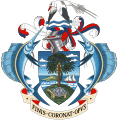
The coat of arms of Prince Edward Island was begun when the shield and motto in the achievement were granted in 1905 by royal warrant of the King Edward VII.
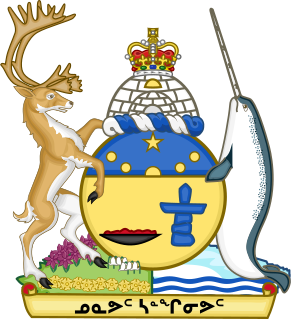
The coat of arms of the territory of Nunavut was granted by a warrant of Roméo LeBlanc, Governor General of Canada, dated 31 March 1999, one day before the territory of Nunavut, Canada, was created. The same document specified the flag of Nunavut.
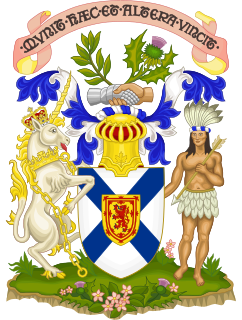
The coat of arms of Nova Scotia is the heraldic symbol representing the Canadian province of Nova Scotia. It is the oldest provincial achievement of arms in Canada, and the oldest British coat of arms in use outside Great Britain. It is blazoned as follows: Argent, a saltire azure charged with an escutcheon of the Royal Arms of Scotland.

The coat of arms of Western Australia is the official coat of arms of the Australian state of Western Australia. It was granted by a royal warrant of Elizabeth II, Queen of Australia dated 17 March 1969.

The coat of arms of the Philippines features the eight-rayed sun of the Philippines with each ray representing the eight provinces which were placed under martial law by Governor-General Ramón Blanco during the Philippine Revolution, and the three five-pointed stars representing the three major island groups of Luzon, the Visayas, and Mindanao.

The coat of arms of Australia, officially called the Commonwealth Coat of Arms, is the formal symbol of the Commonwealth of Australia. A shield, depicting symbols of Australia's six states, is held up by the native Australian animals, the kangaroo and the emu. The seven-pointed Commonwealth Star surmounting the crest also represents the states and territories, while floral emblems appear below the shield.

The coat of arms of Bermuda depicts a red lion holding a shield that has a depiction of a wrecked ship upon it. The red lion is a symbol of Great Britain and alludes to Bermuda's relationship with that country. The Latin motto under the coat of arms, Quo Fata Ferunt, means "Whither the Fates Carry [Us]". The wrecked ship is the Sea Venture. The arms were formally granted by Royal Warrant on 4 October 1910, but had been in use since at least 1624. The coat of arms first appears on the cover of the 1624 edition of The Generall Historie of Virginia, New-England, and the Summer Isles. The "Somers Isles" is another name for Bermuda, named after Sir George Somers, the colony's founder.
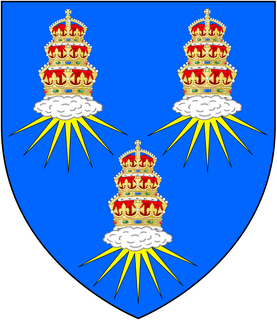
The Worshipful Company of Drapers, informally known as the Drapers' Company and formally known as The Master and Wardens and Brethren and Sisters of the Guild or Fraternity of the Blessed Mary the Virgin of the Mystery of Drapers of the City of London, was probably the first corporate body in England to be granted a coat of arms, on 10 March 1438/9 by Sir William Bruges, Garter King of Arms. The patent dated 1439 is the earliest surviving such grant of arms made to a corporate body in England. The arms were modified in 1561, when the crest was added and the lion supporters granted. These grants were superseded in 1613 with minor modifications. The Queen as Freeman of the Fraternity possesses a small jewelled and enamelled brooch depicting its arms and circumscribed by the motto, known as "The Drapers Company Badge". She wears the brooch when performing royal engagements connected with the Drapers Company. The modern blazon is: Azure, three clouds radiated proper each adorned with a triple crown or. The triple crown contains a cap gules.

The coat of arms of Toronto, Ontario, Canada, was designed by Robert Watt, the Chief Herald of Canada at the time, for the City of Toronto after its amalgamation in 1998. The arms were granted by the Canadian Heraldic Authority on 11 January 1999.

The Coat of Arms of Victoria is the official heraldic symbol of the Australian state of Victoria. Victoria was the second state of Australia to gain arms, granted on 6 June 1910 by royal warrant of King George V. The state had been named in 1851 after his grandmother, who was in reign at the time. The final version of the arms was granted 28 March 1978 in the royal warrant issued by Queen Elizabeth II.

The great seal of the state of Delaware was first adopted on January 17, 1777, with the current version being adopted April 29, 2004. It contains the state coat of arms surrounded by an inscription.

The first coat of arms of Montreal was designed by Jacques Viger, the first mayor of Montreal, and adopted in 1833 by the city councillors. Modifications were made some one hundred five years later and adopted on 21 March 1938, and again on 13 September 2017, resulting in the version currently in use. The coat of arms was the only city emblem representing Montreal until 1981, when a stylized logo was developed for common daily use, reserving the coat of arms for ceremonial occasions.

The coat of arms of Sierra Leone, were developed by the College of Arms and granted in 1960.

The Coat of arms of Bradford City Council was granted in 1976. The present City of Bradford was created in 1974 by the Local Government Act 1972 and is one of five metropolitan boroughs of West Yorkshire. The 1976 arms are based on those of its predecessor, the county borough of Bradford.

The coat of arms of Dominica was adopted on July 21, 1961. It consists of a shield with two guardian sisserou parrots bracing the shield atop of which is a lion passant. The quarters of the shield depict a canoe, a banana tree, a palm and a frog of the native species known as the mountain chicken. Below the shield is the national motto: Apres Bondie C'est La Ter.

The Coat of arms of Penang is largely based on the coat of arms of Penang first granted to the Settlement of Penang, then in the Federation of Malaya, by a Royal Warrant of King George VI dated 11 September 1949.
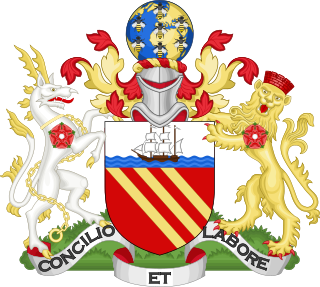
The City of Manchester in North-West England has traditionally been represented by various symbols. Most of these symbols are derived from heraldic emblems contained within the city's official heraldic achievement, which was officially adopted when the Borough of Manchester was granted city status in 1842. Notably, the motif of the worker bee has been widely used to represent the city as a symbol of industry.

Coat of arms of the London Borough of Bexley is the official coat of arms of the London Borough of Bexley, granted on 20 May 1965.

The coat of arms of the London Borough of Hammersmith and Fulham was granted to the then London Borough of Hammersmith on 1 March 1965, but the motto changed languages in 1969. The subsequent change of names to Hammersmith and Fulham on 1 January 1980 did not affect the arms.

The coat of arms of the London Borough of Hillingdon is the official symbol of the London Borough of Hillingdon. They use elements from the coats of arms of the four previous districts. It is described as:
Arms: Per pale Gules and Vert an Eagle displayed per pale Or and Argent in the dexter claw a Fleur-de-lis Or and in the sinister claw a Cog-Wheel Argent on a Chief Or four Civic Crowns Vert.
Crest: On a Wreath of the Colours issuant from a Circlet of Brushwood Sable a demi-Lion Gules with wings Argent the underside of each wing charged with a Cross Gules and holding between the paws a Bezant thereon a Mullet Azure.
Supporters: On the dexter side an Heraldic Tiger Or gorged with an Astral Crown Azure and charged on the shoulder with a Rose Gules charged with another Argent barbed and seeded proper and on the sinister side a Stag proper attired and gorged with a Circlet of Brushwood and charged on the shoulder with two Ears of Rye slipped in saltire Or.
Motto: Forward.




